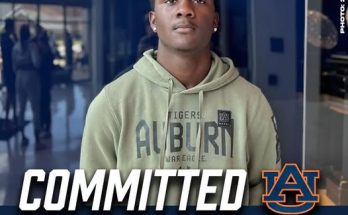Alabama wide receiver Ryan Williams has quickly become one of the most electrifying young stars in college football, and his latest decision has sent shockwaves across the sport. In an era where Name, Image, and Likeness (NIL) deals have reshaped recruiting battles and college allegiances, Williams has chosen a path that bucks the modern trend of chasing the highest bidder. Reports surfaced that the Georgia Bulldogs, Alabama’s fiercest rival in recent years, extended a jaw-dropping NIL offer worth approximately \$4.5 million to lure him away from Tuscaloosa. But instead of entertaining the prospect of wearing red and black, Williams made it crystal clear that his loyalty remains with the Crimson Tide, famously declaring, “I have no plans beyond Alabama.” His decision not only reinforces his commitment to Nick Saban’s program but also raises larger conversations about loyalty, legacy, and the evolving landscape of college athletics.
For context, NIL has dramatically changed the way college football operates. Players now have the opportunity to monetize their talents and build brand partnerships worth millions before ever stepping into the professional ranks. For top recruits and established stars, the tug-of-war between loyalty to a program and the temptation of massive paydays is constant. Ryan Williams found himself in precisely that position, but the way he responded has reminded many fans of a bygone era, when players prioritized school pride, personal development, and legacy over short-term gains. In Williams’ case, the \$4.5 million figure is not something that can be casually dismissed. For an 18-year-old, that type of money represents financial security for life, a chance to take care of family, and a unique opportunity to cash in on fame while still in college. Georgia, which has recently risen to national prominence with back-to-back national championships, saw an opening to weaken Alabama while strengthening its own receiving corps, and it pushed all its chips to the middle of the table. Yet, Williams did not flinch.
The significance of this decision cannot be overstated. Alabama and Georgia are locked in a modern-day college football arms race. Every recruit matters, every playmaker who can tilt the field is crucial, and NIL has become one of the most powerful weapons in this battle. By turning down the Bulldogs’ multimillion-dollar offer, Williams did more than just reaffirm his commitment to Alabama; he rejected the notion that money can define a player’s legacy or dictate his loyalty. He sent a clear message to future athletes and fans alike: some things are worth more than a payday. His decision underscores that Alabama’s culture, tradition, and track record of preparing players for the NFL still carry immense weight. Williams emphasized that he believes Alabama gives him the best chance not only to win championships but also to grow as a player and a person.
Ryan Williams has always been different. Coming out of high school, he was one of the most coveted wide receiver recruits in the nation. With elite speed, fluid route-running, and the ability to make defenders miss in the open field, he earned five-star status and had virtually every major program in the country chasing his signature. Alabama ultimately secured him, and he wasted no time in showing why he was so highly touted. Even as a young player, he quickly became a fan favorite in Tuscaloosa, with his explosive playmaking ability reminiscent of past Crimson Tide greats like DeVonta Smith, Jaylen Waddle, and Jerry Jeudy. It is within that lineage that Williams seeks to leave his mark, and his rejection of Georgia’s NIL deal is another step toward solidifying his place in Alabama’s storied history.
For Georgia, this was not just about landing another talented receiver. It was a strategic move to weaken a direct rival while bolstering its own offensive arsenal. The Bulldogs have established themselves as the standard of excellence in the SEC, dethroning Alabama as the perennial top dog, and luring Williams away would have been a symbolic victory as much as a practical one. But Williams’ decision to stay put is a reminder that Alabama still has one of the strongest recruiting cultures in the nation. It reinforces the idea that Nick Saban’s program continues to thrive on loyalty, trust, and development, even as NIL money tempts players elsewhere.
From a cultural standpoint, Williams’ choice has ignited debates across the college football landscape. Some argue that he left too much money on the table, suggesting that in an uncertain sport where careers can be cut short by injury, maximizing earnings should always be the priority. Others applaud his stance, calling it refreshing in an era where loyalty often seems outdated. Fans, in particular, have rallied behind him, praising his maturity and his long-term vision. The \$4.5 million would have been a life-changing deal, but Williams appears to be thinking beyond immediate cash. He understands that excelling at Alabama could set him up for an NFL career that could dwarf any NIL deal in terms of financial reward. In essence, he is betting on himself and on Alabama’s proven ability to mold wide receivers into first-round draft picks.
The emotional weight of his declaration, “I have no plans beyond Alabama,” resonates deeply with fans who crave authenticity in sports. College football is built on tradition, rivalries, and the connection between players and their schools. Williams’ words echo those values at a time when NIL has blurred the lines between amateurism and professional motivations. His statement communicates that he wants his name to be associated with Alabama, that he is not a mercenary chasing paydays but a player invested in the program’s success. For Crimson Tide fans, this is about more than just retaining a star receiver—it’s about preserving the identity of Alabama football in an era of change.
This decision also has ripple effects in recruiting. Younger players who idolize Williams will take note of his loyalty and the praise he has received for rejecting Georgia’s offer. It strengthens Alabama’s recruiting pitch: that being part of the Tide is about more than just money. It’s about legacy, development, and the chance to be remembered alongside some of the greatest players in college football history. In a practical sense, Williams staying in Tuscaloosa also means continuity for Alabama’s offense. His chemistry with the quarterback, his understanding of the playbook, and his ability to be a reliable target in crucial moments will be vital for the Tide as they continue to chase championships.
For Georgia, this represents a missed opportunity, but it also shows just how competitive NIL battles have become. In the pre-NIL era, schools competed through facilities, coaching staffs, and playing opportunities. Now, NIL collectives act as quasi-recruiters, wielding massive sums of money as incentives. Georgia’s attempt to pry Williams away is not an anomaly—it is the new normal. And yet, Williams’ rejection of it proves that even in this climate, culture and tradition still matter. Alabama’s ability to retain a player despite the size of the offer speaks volumes about the staying power of its program.
It is also worth considering the psychological impact this has on Alabama’s locker room. Teammates see Williams turning down millions to stay with them, and that type of loyalty can galvanize a team. It shows that for all the individual opportunities NIL presents, there is still value in unity and collective pursuit of championships. Alabama has always thrived on that “team first” mentality, and Williams’ decision reinforces it in the most public way possible. For the coaching staff, it is also a win, proving that the relationships they build with players can stand firm against outside financial pressures.
Looking at the bigger picture, Williams’ choice raises questions about how NIL will evolve. While money is undeniably powerful, it is not the only factor in a player’s decision-making process. The balance between financial opportunity, program culture, development, and legacy is delicate, and Williams has shown that money alone cannot override the other elements. His move may inspire other players to weigh their options differently, especially when the programs in question are as elite as Alabama and Georgia.
Ultimately, Ryan Williams’ decision is a defining moment not just for his career but for the ongoing NIL era of college football. It represents a clash between old-school values and new-school realities, and in this case, the old-school approach won. By staying at Alabama, Williams has positioned himself not only to chase championships but to embody what many fans still want college football to represent: loyalty, tradition, and belief in something larger than individual gain. He has made it clear that his identity is tied to Alabama, and that message carries weight in a sport where narratives matter as much as victories.
The story of Ryan Williams will continue to unfold on the field, where his talent will undoubtedly shine. But off the field, his rejection of Georgia’s \$4.5 million NIL offer is already a landmark moment, one that will be remembered as an example of choosing loyalty over money. In a time when college football is shifting rapidly, Williams has become a symbol of what remains unchanged—the passion for a program, the desire to leave a legacy, and the refusal to be swayed by even the most dazzling temptations. For Alabama fans, that loyalty is priceless, and for the broader college football world, it is a reminder that some players still play for more than just the check.



